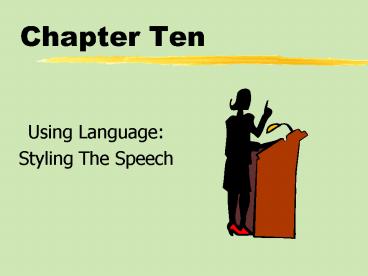Chapter Ten - PowerPoint PPT Presentation
1 / 19
Title:
Chapter Ten
Description:
Speech language should be culturally sensitive, unbiased, simple, concise, concrete, and vivid ... Vivid Imagery. Select adverbs and adjectives that are ... – PowerPoint PPT presentation
Number of Views:61
Avg rating:3.0/5.0
Title: Chapter Ten
1
Chapter Ten
- Using Language
- Styling The Speech
2
Chapter Ten
- Table of Contents
- Writing for the Ear
- Using Language to Share Meaning
- Using Language to Build Credibility
- Using Language to Create a Lasting Impression
3
Writing for the Ear
- Written language and oral language are different
- Readers have the opportunity to re-read text,
listeners have only one chance to get the message
4
Using Language To Share Meaning
- Your choice of language should create shared
meaning between the speaker and the audience
members - Speech language should be culturally sensitive,
unbiased, simple, concise, concrete, and vivid
5
Using Language To Share MeaningCulturally
Sensitive Language
- Cultural Sensitivity
- A conscious attempt to be considerate of cultural
beliefs, norms, or traditions that are different
from ones own
6
Using Language To Share MeaningUnbiased Language
- Biased language
- Language that relies on unfounded assumptions,
negative descriptions, or stereotypes of a given
groups age, class, gender, or geographic,
ethnic, racial, or religious characteristics
also includes language that is sexist, ageist, or
homophobic - Sexist Pronouns
- The exclusive use of he, she, him, her, when
talking about both men and women
7
Using Language To Share MeaningSimplicity
- Successful speakers say what they mean in short,
clear sentences - Jargon
- The specialized language of a given profession
- Avoid using jargon, unless the audience consists
of specialized professionals
8
Using Language To Share MeaningConciseness
- Strive to use as few words as possible to express
your thoughts - Eliminate the unnecessary use of conjunctions
such as, and, but, for, although, because, since,
and as soon as - Vocal fillers such as um, and ahh, alienate
listeners because they distract from the point
9
Using Language To Share MeaningConcreteness
- Concrete Language
- Words that are specific, tangible, and definite
- Abstract Language
- Words that are general and nonspecific
10
Using Language To Share MeaningVivid Imagery
- Select adverbs and adjectives that are colorful
and concrete - Appeal to the listeners senses of smell, taste,
sight, hearing, and touch
11
Using Language To Share MeaningVivid Imagery
- Try to use Figures of Speech
- A simile is an explicit comparison of one thing
to another, using like or as - A metaphor is a direct comparison of two things
in which one thing is describes as actually being
the other - An analogy is an extended metaphor or simile that
compares an unfamiliar concept or process to a
more familiar one to help the listener understand
the unfamiliar one
12
Using Language to Build Credibility
- Proper language usage builds trust and
credibility - By being appropriate, accurate, and showing
conviction for your topic, you demonstrate
trustworthiness
13
Using Language to Build CredibilityAppropriatene
ss
- Language that is appropriate in one context or
for one audience, may be inappropriate in another - Avoid inflammatory language that may incite anger
in the audience - Avoid slanderous or libelous language that may
defame the reputation of others
14
Using Language to Build CredibilityAccuracy
- Denotative meanings
- The literal, or dictionary definition of a word
- Connotative meanings
- The special associations that different people
bring to bear upon a word - Report the information in your speech accurately,
and without distorting the facts
15
Using Language to Build CredibilityConfidence
and Conviction
- Speaking in the active rather than the passive
voice will make your statements clear and
assertive instead of indirect and weak - Personal pronouns such as I, me, and my create
an impression of conviction
16
Using Language To Create A Lasting Impression
- The way in which statements in a speech are
arranged helps the audience remember the speech
better
17
Using Language To Create A Lasting
ImpressionRepetition
- Repetition involves repeating key words or
phrases at various intervals to create a
distinctive rhythm - Keywords or phrases normally appear first in the
introduction, then are repeated in the body and
the conclusion of the speech
18
Using Language To Create A Lasting
ImpressionAlliteration
- Alliteration is the repetition of the same
sounds, usually initial consonants, in two or
more neighboring words or syllables - Alliteration lends speech a poetic, musical
rhythm which drives home a point and leaves a
lasting impression
19
Using Language To Create A Lasting
ImpressionParallelism
- Parallelism is the arrangement of words, phrases,
or sentences in a similar form
- Example
- Ask not what your country can do for you, ask
what you can do for your country































